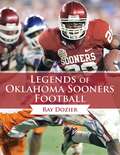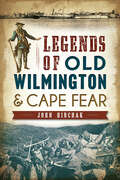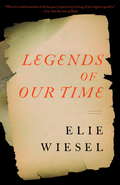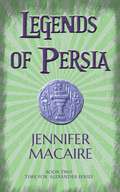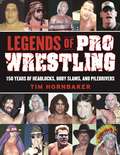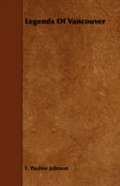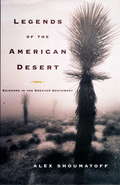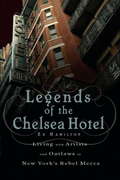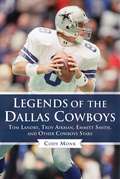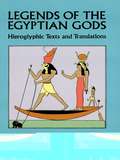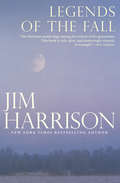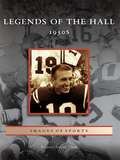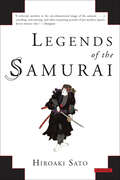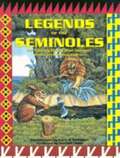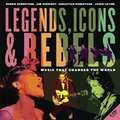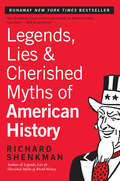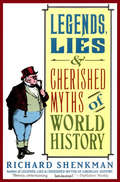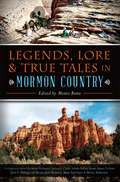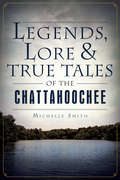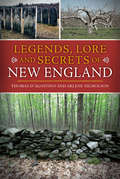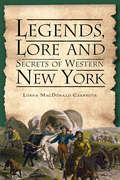- Table View
- List View
Legends of Oklahoma Sooners Football
by Ray DozierSince 1895, the University of Oklahoma football program has amassed some impressive numbers: seven national championships, 47 consecutive wins, 44 conference championships, 28 bowl wins, five Heisman Trophy winners, and more than 150 All-America players. In Legends of Oklahoma Sooners Football, Ray Dozier profiles 36 players and coaches who provided the talent and inspiration that put Sooner football on the national sports landscape.Many of those legends played before the dawn of the television era, but standouts such as Forest "Spot"Geyer, Tommy McDonald, Prentice Gautt (the first black football player at the University of Oklahoma), Clendon Thomas, and Bob Kalsu remain alive and well in the hearts and minds of loyal Sooner fans. The legends of Sooner stars such as Steve Owens, Joe Washington, Jack Mildren, the Selmon brothers, Billy Sims, Greg Pruitt, Tony Casillas, Brian Bosworth, Adrian Peterson, and Sam Bradford continue to grow with time. Coaching legends include Bennie Owen, Bud Wilkinson, Barry Switzer, and the all-time leader in wins, Bob Stoops.Legends of Oklahoma Sooners Football chronicles the players, coaches, rivalries, and events that transformed a club team that played its first games on a dusty territorial prairie into a national powerhouse.
Legends of Old Wilmington & Cape Fear
by John HirchakSituated on the banks of the Cape Fear River, Wilmington is awash in unusual tales and legends. A prevalent pirate hideaway, the area harbored the infamous Blackbeard and the cunning Calico Jack Rackham. Since its initial settlement, the region has witnessed an abundance of fantastical lore, including passionately fought duels, explosive train wrecks, Revolutionary and Civil War heroes and some legends that are said to take the form of apparitions. At the local Cape Fear Wine & Beer pub, the ghost of a fallen redcoat can't seem to get enough of a frothy porter brewed from yeast salvaged from an early nineteenth-century shipwreck. Wonder at these and other fascinating and strange tales as local author John Hirchak reveals the legendary history of Wilmington and Cape Fear.
Legends of Our Time
by Elie WieselA collection of tales immortalizing the heroic deeds and visions of people Wiesel knew during and after World War II.From the Trade Paperback edition.
Legends of Persia
by Jennifer MacaireAfter winning a prestigious award, Ashley is chosen to travel through time and interview a historical figure. Choosing her childhood hero Alexander the Great, she is sent back in time for less than a day. He mistakes her for Persephone, goddess of the dead, and kidnaps her, stranding her in his own time. What follows, after she awakes under the pomegranate tree, is a hilarious, mind-bending tale of a modern woman immersed in the ancient throes of sex, love, quite a bit of vino, war, death, and ever so much more.
Legends of Pro Wrestling: 150 Years of Headlocks, Body Slams, and Piledrivers
by Tim HornbakerLegends of Pro Wrestling offers the first comprehensive look at the entire world of wrestling. With detailed biographies and never-before-seen statistics of some of the greatest athletes in the sport, you will be able to read about hundreds of wrestlers, dating back to the mid-1800s. As the first of its kind, this centralized reference book offers wrestling enthusiasts a range of information at their fingertips and stands alone as the ultimate wrestling resource.This book offers readers a link between what happened a century ago to what is currently happening today. An older fan of Bruno Sammartino or "The Nature Boy" Buddy Rogers can enjoy this book as much as someone who follows John Cena or The Undertaker today. This collection is a never-ending source of facts, figures, and other entertaining data.Professional wrestling is a world of accomplishment, legacy, and, most importantly, fate. Through injuries, sickness, and family tribulations, many wrestlers have given everything they have to give in the ring, and true fans of the sport love every single second of it. No matter your age, if you're a fan of professional wrestling, Legends of Pro Wrestling is the book for you to own and cherish.Skyhorse Publishing, as well as our Sports Publishing imprint, is proud to publish a broad range of books for readers interested in sports-books about baseball, pro football, college football, pro and college basketball, hockey, or soccer, we have a book about your sport or your team.In addition to books on popular team sports, we also publish books for a wide variety of athletes and sports enthusiasts, including books on running, cycling, horseback riding, swimming, tennis, martial arts, golf, camping, hiking, aviation, boating, and so much more. While not every title we publish becomes a New York Times bestseller or a national bestseller, we are committed to publishing books on subjects that are sometimes overlooked by other publishers and to authors whose work might not otherwise find a home.
Legends of Vancouver
by E. Pauline JohnsonI NEVER saw that land before, And now can never see it again Yet, as if by acquaintance hoar Endeared, by gladness and by pain, Great was the affection that I bore To the valley and the river small, The cattle, the grass, the bare ash trees, The chickens from the farmsteads, all Elm-hidden, and the tributaries Descending at equal interval The blackthorns down along the brook With wounds yellow as crocuses Where yesterday the labourers hook Had sliced them cleanly and the breeze That hinted all and nothing spoke. I neither expected anything Nor yet remembered but some goal I touched then and if I could sing What would not even whisper my sul As I went on my journeying, I should use, as the trees and birds did, A language not to be betrayed And what was hid should still be hid Excepting from those like me made Who answer when such whispers bid. DARK is the forest and deep, and overhead Hang stars like seeds of light In vain, though not since they were sown was bred Anything more bright. And evermore mighty multitudes ride About, nor enter in Of the other multitudes that dwell inside Never yet was one seen. The forest foxglove is purple, the- marguerite Outside is gold and white, Nor can those that pluck either blossom greet The others, day or night. CELANDINE THINKING of her had saddened me at first, Until I saw the sun on the celandines lie Redoubled, and she stood up like a flame, A living thing, not what before I nursed, The shadow I was growing to love almost, The phantom, not the creature with bright eye That I had thought, never to see, once lost. She found the celandines of February Always before us all. Her nature and name Were like those flowers, and now immediately For a short swift eternity back she came, Beautiful, happy, simply as when she wore Her brightest bloom among the winter hues Of all the world and I was happy too, Seeing the blossoms and the maiden who Had seen them with me Februarys before, Bending to them as in and out she trod And laughed, with locks sweeping the mossy sod. But this was a dream the flowers were not true, Until I stooped to pluck from the grass there One of five petals and I smelt the juice Which made me sigh, remembering she was no more, Gone like a never perfectly recalled air. . .
Legends of the American Desert
by Alex ShoumatoffFor his brilliant reportage ranging from the forested recesses of the Amazon to the manicured lawns of Westchester County, New York, Alex Shoumatoff has won acclaim as one of our most perceptive guides to the oddest corners of the earth. Now, with this book, he takes us on a kaleidoscopic journey into the most complex and myth-laden region of the American landscape and imagination. In this amazing narrative, Shoumatoff records his quest to capture the vast multiplicity of the American Southwest. Beginning with his first trip after college across the desert in a station wagon, some twenty-five years ago, he surveys the boundless variety of people and experiences constituting the place--the idea--that has become America's symbol and last redoubt of the "Other. From the Biosphere to the Mormons, from the deadly world of narcotraffickers to the secret lives of the covertly Jewish conversos, Shoumatoff explores the many alternative states of being who have staked their claim in the Southwest, making it a haven for every brand of refugee, fugitive, and utopian. And as he ventures across time and space, blending many genres--history, anthropology, natural science, to name only a few--he brings us a wealth of information on chile addiction, the diffusion of horses, the formation of the deserts and mountain ranges, the struggles of the Navajo to preserve their culture, and countless other aspects of this place we think we know. Full of profound sympathy and unique insights, Legends of the American Desert is a superbly rich epic of fact and reflection destined to take its place among such classics of regional portraiture as Ian Frazier's Great Plains. Alex Shoumatoff has created an exuberant celebration of a singularly American reality.
Legends of the Chelsea Hotel: Living with Artists and Outlaws in New York's Rebel Mecca
by Ed HamiltonThere's a current that courses through the old Chelsea Hotel, an electricity that drives people relentlessly to create. It's an energy that longtime resident and creator of "Living with Legends: Hotel Chelsea Blog" Ed Hamilton will tell you often drives inhabitants to madness. In a series of linked cyanide capsules, Legends of the Chelsea Hotel tells the odd, funny, and often tragic truth of the writers, artists, and musicians - the famous and the obscure alike - who have fallen prey to the Chelsea. Readers enter one of Dee Dee Ramone's flashbacks; meet the ghost of author Thomas Wolfe; learn of movie star Ethan Hawke's mystical powers over women; see the ungodly acts allegedly being perpetrated in the basement club Serena's; and feel the dark aura of Room 100, where punk rocker Sid Vicious killed his girlfriend Nancy. Other Chelsea residents past and present who will be included: Ryan Adams, club kid/murderer Michael Alig, Sarah Bernhardt, the Warhol Factory's Richard Bernstein, Victor Bockris, Charles Bukowski, Leonard Cohen, Lesbian activist Storme DeLarverie, Bob Dylan, Allen Ginsberg, Herbert Huncke, Janis Joplin, Jack Kerouac, Madonna, Edgar Lee Masters, Arthur Miller, Edie Sedgwick, Sam Shepard, Patti Smith, Dylan Thomas, and Rufus Wainwright.
Legends of the Dallas Cowboys: Tom Landry, Troy Aikman, Emmitt Smith, and Other Cowboys Stars (Legends of the Team)
by Cody MonkFive Super Bowl titles, fifteen Hall of Famers, and a litany of legendary players, characters, and games later, the Dallas Cowboys franchise has cemented itself among the most successful in all of sports and, with a fan base that extends all over the world, among the most well known.Legends of the Dallas Cowboys takes an in-depth look at some of the legends who have shaped the Cowboys’ identity, beginning with Tom Landry, the man who was hired before Murchison had been awarded a team and who is still the franchise’s enduring image. Also included is Tex Schramm, under whom the Cowboys had twentystraight winning seasons and who is considered the most forward-thinking NFL executive ever, as well as Randy White, Ed “Too Tall” Jones, Bob Lilly, Lee Roy Jordan, Mel Renfro, and more. Also included are innovators such as Bob Hayes, who forced the creation of the zone defense, and Michael Irvin and Thomas “Hollywood” Henderson, who forced the creation of behavioral clauses in contracts. Each of the legends played his own unique role in shaping the lore of one of sports’ greatest franchises, a franchise that began humbly on a winter day in Miami and is now a model of success.
Legends of the Egyptian Gods: Hieroglyphic Texts and Translations
by E. A. BudgeFormer Keeper of Egyptian and Assyrian Antiquities in the British Museum, E. A. Wallis Budge (1857-1934) was one of the great Egyptologists of the century and author of a host of books on ancient Egypt. For this collection, he carefully selected nine of the most interesting and important Egyptian legends and published them in hieroglyphic texts with literal translations on facing pages. The result is a wonderful sampling of typical Egyptian literature in the best and most complete form possible.This convenient edition enables students to study these ancient myths for their linguistic, literary, and cultural meanings — all in one inexpensive volume. The legends included are:The Legend of the CreationThe Legend of the Destruction of MankindThe Legend of Ra and the Snake-BiteThe Legend of Horus of Edfu and the Winged DiskThe Legend of the Origin of HorusA Legend of Khensu Nefer-Hetep and the Princess of BekhtenThe Legend of Khnemu and a Seven Years’ FamineThe Legend of the Death and Resurrection of HorusThe Legend of Isis and Osiris According to Classical WritersAny student of ancient Egyptian literature, language, or culture will welcome this classic compilation, enhanced with 19 illustrations from Egyptian art.
Legends of the Fall (Colección Vib Ser. #Vol. 50)
by Jim HarrisonThree novellas by the New York Times bestselling author, including the classic tale of brotherhood from the Montana plains through the horrors of WWI. Jim Harrison&’s critically acclaimed novella &“Legends of the Fall&”—which was made into the film of the same name—is an epic tale of three brothers fighting for justice in a world gone mad. Moving from the expansive landscape of early twentieth-century Montana to the blood-drenched battlefields of World War I Europe, Harrison explores the desperate actions of which men are capable when their lives or aspirations are threatened. Also including the novellas &“Revenge&” and &“The Man Who Gave Up His Name,&” Legends of the Fall confirms Jim Harrison&’s reputation as a writer who &“stands high among the writers of his generation. This book is rich, alive, and shatteringly visceral. A triumph&” (New Yorker). &“I can&’t begin to do justice to the nuances of character and honest complexities of plot in this work. The writing is precise and careful—and sings withal.&” —Raymond Carver, Washington Post Book World
Legends of the Hall: 1950s (Images of Sports)
by Kristine Setting ClarkLegends of the Hall: 1950s captures a period of time when playing professional football was for tough, honest men who played solely for the love of the game. The 1950s was an era of crew cuts and nicknames like Crazylegs, Hopalong, and Night Train. The decade began with Sammy Baugh throwing his last passes and ended with the death of Bert Bell. This era also produced some of the greatest quarterbacks ever to play the game. They were known as the glamour boys of the league--Otto Graham, Bob Waterfield, Bobby Layne, Y. A. Tittle, and Bart Starr, to name a few. The incomparable, individual brilliance and unique team chemistry that marked this era have transcended this specific time and place to make Legends of the Hall: 1950s an unforgettable part of the magic and myth of professional football.
Legends of the Samurai
by Hiroaki SatoThis authoritative history of Japan’s elite warrior class separates fact from myth as it chronicles centuries of samurai combat, culture, and legend.In Legends of the Samurai, Hiroaki Sato examines the history of these medieval Japanese warriors, as well as the many long-standing myths that surround them. In doing so, he presents an authentic and revealing picture of these men and their world. Sato’s masterful translations of original samurai tales, laws, dicta, reports, and arguments are accompanied by insightful commentary. With incisive historical research, this volume chronicles the changing ethos of the Japanese warrior from the samurai's historical origins to his rise to political power. A fascinating look at Japanese history as seen through the evolution of the samurai, Legends of the Samurai stands as the ultimate authority on its subject.
Legends of the Seminoles
by Peter Gallagher Betty M Jumper Guy LaBreeLate at night around the campfires, Seminole children safely tucked into mosquito nets used to listen to the elders retelling the old stories and legends. The priceless tales of mischievous Rabbit, the Corn Lady, the Deer Girl, and the creatures of the Everglades are all written down and collected here for readers of all ages. This is a portrait of the beliefs and lifeways of the Seminoles of Florida as well as a delightful read for anyone interested in the first peoples of Florida.
Legends of the West: Part 3
by X. F. MoixMountain range of the Pyrenees, Iberian peninsula. A peasant dies under strange circumstances. Suspecting supernatural and evil nature of the event, father Isidro is sent to investigate the incident. But there are more ancient and dangerous secrets hidden in the heart of these cursed mountains, remembered by the last survivors of a time in which the fog was able to cover too discouraging truths... Now that veil has been torn and the threat is released. If no one would restrain it, the chaos will explode. The night is coming when the stories that fueled imagination of the little ones will turn into reality to frighten even the most skeptical men... Who will be able to maintain sanity when collapse the firm pillars that sustain the reality? Magic, witchcraft and ancestral secrets will shake the orthodoxy of Christianity. An adventure that will take us back to the depths of the Pyrenees, in a borderland, where the impossible seems more real than it's desired by the common sense of the majority. Would you be the one to challenge it, to pursue the most uncomfortable and archaic mysteries? Every tree, hill, lake, and cave belongs to two worlds; one of them we ignore. Its outlawed inhabitants have fueled the fantasies of popular folklore... until now. In front, the old paths that lead us towards them are outlined and are waiting for us.
Legends, Icons & Rebels: Music That Changed the World
by Robbie Robertson Jim Guerinot Sebastian Robertson Jared LevineMusic industry veterans Robbie Robertson, Jim Guerinot, Jared Levine, and Sebastian Robertson invite young readers to share with them in celebrating twenty-seven musical legends. Short profiles chronicle personal stories and achievements of extraordinarily talented artists whose innovations changed the landscape of music for generations to come. Compiled like any great playlist, the line-up features originators, rebels, and risk-takers across diverse genres. From Ray Charles to Johnny Cash, Chuck Berry to Bob Dylan, Robertson shares anecdotes about these artists and the influence they had on his own musical journey.
Legends, Lies & Cherished Myths of American History
by Richard ShenkmanThe truth and nothing but the truth—Richard Shenkman sheds light on America's most believed legends. The story of Columbus discovering the world was round was invented by Washington Irving. The pilgrims never lived in log cabins. In Concord, Massachusetts, a third of all babies born in the twenty years before the Revolution were conceived out of wedlock. Washington may have never told a lie, but he loved to drink and dance, and he fell in love with his best friend's wife. Independence wasn't declared on July 4th. There's no evidence that anyone died in a frontier shootout at high noon. After World War II, the U. S. government concluded that Japan would have surrendered within months, even if we had not bombed Hiroshima and Nagasaki.
Legends, Lies & Cherished Myths of World History
by Richard ShenkmanA humorous take on world history debunks the myths that surround Cleopatra, Nero, Robin Hood, King Arthur, Joan of Arc, and other historical icons.
Legends, Lies and Cherished Myths of American History
by Richard Shenkman*The story that Columbus discovered that the world was round was invented by Washington Irving. * The pilgrims never lived in log cabins. *In Concord, Massachusetts,a third of all babies born in the twenty years before the Revolution were conceived out of wedlock. *Washington may have never told a lie, but he loved to drink and dance, and he fell in love with his best friend s wife. * Independence wasn't declared on July 4 (and the Liberty Bell was so little regarded that Philadelphia tried to sell it for scrap metal but nobody wanted it). * There's no evidence that anyone died in a frontier shootout at high noon. * After World War II, the U.S. Government concluded that Japan would have surrendered within months, even if we had not bombed Hiroshima and Nagasaki. "Richard Shenkman has done a superb job of uncovering our most cherished myths.
Legends, Lies and Cherished Myths of World History
by Richard ShenkmanMORE OF THE TRUTH & NOTHING BUT. Bestselling author of Legends, Lies & Cherished Myths of American History now takes on the world! Skewering the nonsense we were all taught about the world's revolutions, religions, heroes, and inventors, Legends, Lies & Cherished Myths of World History is a whirlwind tour of history from the Trojan War to World War II. Eclectic and fun, Richard Shenkman's well- documented revelations prove that much of history is indeed "but a fable agreed upon." For example: * Queen Victoria may have usually worn black, but she loved to drink and party. * During World War II the English were conned into believing it was Winston Churchill who broadcast the speech about this being their finest hour. But it wasn't Churchill, it was Norman Shelley, a radio actor hired as a stand-in. * Marie Antoinette did not say, "Let them eat cake," Churchill didn't coin the phrase "the Iron Curtain," and Caesar never said, "Et tu, Brute?" * Scandal in the English monarchy is nothing new: Fifteen kings fathered children out of wedlock. One queen helped depose her husband so her lover could take his place. Three English kings were gay. Richard Shenkman is the author of the New York Times bestseller Legends, Lies & Cherished Myths of American History and I Love Paul Revere Whether He Rode or Not, as well as the coauthor of One-Night Stands with American History. He lives in Seattle.
Legends, Lore & True Tales in Mormon Country (American Legends)
by Steve Clark James Nelson Eileen Hallet Stone Monte Bona Christian ProbascoUtah's Mormon Pioneer National Heritage Area offers breathtaking natural resources, powerful historical drama and intriguing cultural traditions. This rich legacy is built on old-world values of cooperation, industry, ingenuity and true grit--as well as a miracle or two. From frontier justice and lost treasure to the lasting contributions of a Presbyterian minister and a Jewish settlement, talented regional historians, educators and storytellers bring to life these legends, lore and true tales from the heart of Mormon country.
Legends, Lore & True Tales of the Chattahoochee (American Legends)
by Michelle SmithThe Chattahoochee Trace in southeast Alabama and west Georgia is steeped in Native, African and early American tradition--stories often deeply rooted in folklore. Unusual beasts such as the Kolowa, the Wampus Cat and even Bigfoot roam the area. Crossroads magic, hoodoo and Huggin' Molly make their homes in the storied region. The Native American trickster rabbit, the Nunnehi Cherokee watchers, the tales of the Indian mounds and the saga of Brookside Drive are forever etched in Chattahoochee lore. From the Creek wars to Indian removal and Sherman's March to the Sea, the legends of "the Hooch" have left an indelible mark on Georgia and Alabama. Join author Michelle Smith as she reveals many of the strange creatures and myths that sing "the Song of the Chattahoochee."
Legends, Lore and Secrets of New England (American Legends)
by Thomas D'Agostino Arlene NicholsonNew England's history is marked with witch executions, curses and an untold number of cemeteries hiding mysteries beneath their stones. In this sometimes harsh landscape, the truth is often stranger than fiction. Examine the footprints burned into the ledge of Devil's Foot Rock in Rhode Island. Spend a night at the Kennebunk Inn in Maine, where the mischievous specter of Silas Perkins still resides. Traverse an old dirt road near Sterling, Connecticut, where the Darn Man's frozen body was uncovered in 1863. Authors Thomas D'Agostino and Arlene Nicholson uncover the history behind the region's best-kept secrets and lore. As you flip through these pages of New England's legends, tread lightly--you just might find a story that will follow you home.
Legends, Lore and Secrets of Western New York (American Legends)
by Lorna Macdonald CzarnotaLike the region's first inhabitants, the 'Cat People,' who made clothing from the mountain lions and panthers that they hunted, Western New Yorkers still savor the tradition of storytelling. Tales such as the 'Mail-Riding Mamma' of Chautauqua County, who carried both the post and her infant child above her head as she journeyed across perilously flooded creeks, and the Ossian Giant, who at age nineteen stood seven feet, six inches tall and weighed 385 pounds, are vividly narrated by Buffalo storyteller Lorna MacDonald Czarnota. Listen to the whispered legends of spirits, heroes and traitors hidden in one of New York's most captivating regions.
Legends, Lore and True Tales of Utah (American Legends)
by Lynn AraveLegends, Lore and True Tales of Utah explores an eclectic pastOrdinary history books often fail to address the obscure or the unexplained, leaving questions buried in annals of yesteryear. Where were Utah's mythical monsters, including Bigfoot, spotted? How did 'Schoolmarm's Bloomers' become a state symbol? What created the Lagoon Amusement Park's 'dark side'? Why did 'Frankenstein' prowl through the Cache town of Clarkston? Does Sardine Canyon hide the state's fishiest story? Exactly what was the 'Lakemobile' that rolled through the Great Salt Lake? When and why did BYU temporarily ban football? How is it that the first college basketball team to ever play in the state was all women, and they beat the men? Retired journalist Lynn Arave presents this unique collection, including over a hundred photographs, of the Beehive State's offbeat history.
